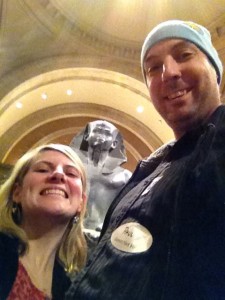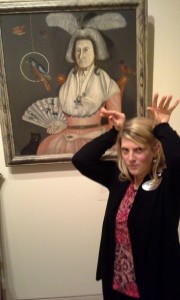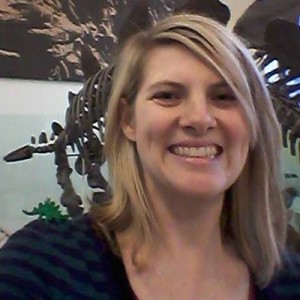How do you get started writing professionally? How do you know what to write about?
These were among the questions that Will Crow, writer/museum educator at the Metropolitan Museum of Art, and I discussed recently at a program on writing as part of professional work. During the evening, sponsored by the New York City Museum Education Roundtable (NYCMER), I mentioned that I often get ideas from museum colleagues on social media, and also from listening to Museum Life, a weekly discussion of museum issues hosted by Carol Bossert on Voice America satellite radio. In fact, I said, the most recent program was an interview with the founders of Museum Hack, and I had listened with a mix of thoughts and emotions. I was thinking of blogging about it. To my delight, because I had also mentioned that I welcome guest posts, two NYCMER members approached me about contributing to a discussion of Museum Hack on this blog. They had thoughts they wanted to share, and they were taking to heart the theme of the evening – if you are going to write, you just have to get busy and do it!
We agreed that the posts would be a combination of their thoughts about Museum Hack and their responses to a number of questions I posed to them about the tour company..
Just a little background. Museum Hack is a company begun by a man who discovered and fell in love with museums when he moved to New York. He began by taking a few friends on tours of his favorite objects, and his presentations were so popular he developed them into a business that provides tours to small groups for about $60-70 per person. Their website states, “Museum Hack is a highly interactive, fun, subversive non-traditional museum tour. We are a band of renegade tour guides. We will lead you in Metropolitan Museum of Art and the American Museum of Natural History on an adventure led by passionate storytelling and juicy gossip.” For more information I recommend listening to the Museum Life interview mentioned above.
Here’s the first guest post, from Margaret Hughes, Education Manager at Historic Hudson Valley in Pocantico Hills, NY.
In February, my husband (a Gen-Xer) and I (millennial) did Hack tours at AMNH and the Met. These tours were among the most dynamic museum visits I’ve ever had. I was impressed not just with the quality of the tours, but also with the way that each experience was carefully constructed. Within the first five minutes of the AMNH tour, our guide shared Hack’s mission: to connect millennials to museums. It’s about cultivating a transferrable skill in a specific demographic. This mission was reinforced throughout the tour, both in terms of content and the interpretive/engagement strategies. I was impressed through the whole tour that every choice was made with the mission in mind. (Effective, mission-centric intentionality? It’s the holy grail of programming.)
Our guides allowed us to have fun and be irreverent. This meant the inclusion of salacious material, always appealing to younger audiences. But it also meant breaking some self-imposed ideas about appropriate museum behavior. Museum educators rarely have problems standing in front of a statue acting out the pose. On field trips, we lead students in similar bodily/kinesthetic activities to help them connect with an artwork. But this activity gets checked at the door after a certain age. Also, it’s typically used for making a “serious” connection with art (i.e., How does the pharaoh’s pose convey power/authority?). Instead, we found a wonky portrait in the early American gallery and took an #UglySelfie with it. For irreverent and ego-centric millennials, this was a great way to present art on their terms.
I also want to make note of the joy that the Hack guides brought to the experience. I can think of plenty of powerful or thought-provoking museum tours I’ve done, but I’ve never been on tours that made being in a museum such a fun experience. (Though the fun never dominated the learning—these were incredibly informative tours.) If part of Hack’s mission is to get millennials to recognize that museums are places for them, I think Hack has done a remarkable job.
Below are Margaret’s responses to some questions I posed:
GJ: Is this an example of “the sage on the stage” rather than “the guide on the side”?I haven’t been on a tour but as the two leaders described it on Museum Life, it felt very “showy” and leader-centric to me.
MH:I don’t think Hack guides fall neatly into this dichotomy..
In a December 2014 interview with Nina Simon on Museum 2.0, Hack guide Dustin Growick described his role as “museum personal trainer.” I loved this description, because it captured both the fact that this individual has knowledge/experience that most of us don’t (cool & interesting knowledge) and s/he wants to help us increase our own capacity. It’s about sharing, not showing off how much the guide knows, and it’s also about building capacity in visitors.
Hack also uses a variety of approaches throughout the tour, opportunities for individual exploration and group discussion. In the jewel room of AMNH, we were all asked to find our favorite gem and brainstorm how we would steal it (an activity inspired by an actual occurrence at the museum and probably not an engagement technique included on a museum-sanctioned tour). In the dinosaur hall, we each received a plastic dinosaur. We had to find our dinosaur’s fossil, learn something about it, take a #DinoSelfie, and then present our dino to the rest of the group. At the Met, we did a living tableau of Washington Crossing the Delaware. These were all exercises that (1) allowed for individual exploration; (2) connected individual to group; (3) gave us permission to have fun and connect with the museum. Some of these also were techniques that visitors could use in the future, on their own or with friends.
There wasn’t much that was particularly new or innovative about Hack’s approaches, as they readily admit. Instead, they use good tools effectively.
GJ: Isn’t it a regressive model? As museums are trying to be more inclusive, give visitors more autonomy, this seems an expensive elitist model with the authority of the museum exchanged for the authority of the guide.
MH: I want to tackle these as two separate issues– first, inclusivity/visitor autonomy, and second expense/elitism.
Inclusivity/visitor autonomy relates to the point above regarding authority. Museums have become more inclusive in efforts to recognize visitors’ own rich experience and to include more points of entry and diverse narratives. To this end, we’ve moved away from approaches that tell visitors what they should appreciate and why. We want visitors to have more control over their experiences, from what they look at to the meaning they make.
I had the feeling that our AMNH tour hit everything that our guide intended. (The tour had gone as scripted.) But by engaging us throughout and connecting content to us personally, it didn’t feel like the type of lecture-based guided tour that most of us regard with dread.
To the point about exchanging authority from museum to guide–what I think happened was that the “authority” of the guides translated as authority that could belong to any member of the group. Both the Hack leaders and the Hack guides make it clear that they didn’t have specialized training or access to unique resources. (Indeed, at AMNH, the guide encouraged all of us to visit the museum’s library, open to the public.) They weren’t saying, I’m the authority, listen to me. Instead they demonstrated that anyone could pursue this type of knowledge. (You could even say they were modeling a type of “lifelong learning” and empowering the tour participants to do the same.)
In thinking of autonomy, I think we sometimes perhaps forget how daunting this can be. When I studied Museum Education at George Washington University, we discussed the “3 Cs”: comfort, confidence, choice. I think that these go in a particular order: visitors first feel comfortable in their surroundings, then confident about what they are doing, and finally empowered to choose their experience. The Hack tours did a great job of walking visitors through the process, helping new museum-goers get acclimated to the museum and finally empowered to explore on their own. As “personal trainer” Dustin Growick put it, “Sometimes all you need is a little help using the equipment.” Hack is helping people learn to use the equipment of museums.
Regarding elitism–yes, yes it is. Hack charges a lot of money for the experience. As the museum field is debating admission costs, Hack takes charging as a given and caters to the segment of the millennial audience with disposable income for such experiences. Hack says they are about connecting millennials to museums. But really it’s the millennials who can afford to pay the hefty fee. And I think this is where it’s really interesting to think about the relationship between museums and Hack. Can we learn from Hack (because I would argue there are things we can learn, or at least be reminded of) and emulate what works without forsaking our other responsibilities?
GJ:Is it a sustainable model? Seems sustainable for the tour company, especially as they are expanding into training museums to do these kinds of tours. Is it sustainable for museums? Seems like museums might be able to do more interactive tours, but having just 8 or 10 people in the group, while ideal, might be hard in terms of scheduling and staffing. On the other hand, is it bringing in a new, underserved audience – 20 or 30 somethings who don’t usually go to museums?
MH I agree–sustainable for Hack but not for museums. However, with the aging out of the traditional museum audiences (& donor pools) comes the need to supplement the numbers and monies from new generations. Can the Hack approach introduce the millennial generation to museums, the first step toward cultivating them as regular members, donors, supporters? There’s nothing in Hack’s approach (as far as I can tell, from interviews as well as from my experiences) that in any way relates to creating a sustained relationship between visitor and museum. Hack wants to raise awareness of the value of museums and equip people to curate their own museum visits. But then it’s up to those of us working in museums to connect with our communities and collaborate with our communities to create sustained relationships.
Yes, there are some elements of Hack that are troubling for museum professionals or that fly in the face of our own efforts. Still, can (and will) museums learn from Hack and benefit from the increased enthusiasm they cultivate to advance the ongoing work we do? We certainly can’t ignore Hack, so how can we use this phenomenon to advance our field?
We hope to have at least one more guest post on this topic, and there has been lots of discussion on AAM’s forum, Museum Junction.
If you would like to respond directly to Margaret, please email her at mhughes@hudsonvalley.org. Or you can comment on this blog, www.museumcommons.com or @gretchjenn on Twitter.
Have you been on a Hack tour? Has your museum attended one of their workshops? Share your thoughts and experiences.



Pingback: Intro 5: Museum Hack, New York | KIWI LOOSE IN MUSEUMS
Thanks for your comment.
Pingback: Museum Commons Explores the Museum Hack Concept - Museum Hack
Hi Ellen,
Thanks for your comment! I’m glad you brought this up, because it’s something I was thinking about as well and wanted to include in my post, but I also wanted to keep the post a readable length. (Editing…the hardest part of the writing process!)
One of my concerns about the Hack/museum relationship is thinking about the responsibilities that museums have that do not encumber Hack. Museums have collections stewardship, broader missions, community connections, and—perhaps most relevant here—a dedication to making our institutions accessible to all. The Hack approach, while absolutely fantastic, is very much designed for a select audience who can afford to pay for it. Museums have limited resources (financially as well as staff-wise), and we have to think about balancing the staff to do all the things we need to do. How can we make the best use of our resources to do all that we are committed to? As we think about introducing expensive ticket/high engagement offerings, what does that mean for the opportunities available for the rest of our visitors?
On the flip side, there’s no reason we can’t make our tours more engaging, more fun, and better support our staff to exude the joy that the Hack guides do.
I hope others will chime in as well, especially those who have participated in Hack’s workshops for museums. Here’s another question: can a museum hack itself? (Taking the jewel room tour from AMNH as an example—what are we willing to talk about, or not, from our museum’s collections or institutional history.)
I had wanted to attend that NYCMER event but was out of town. Now I am really sorry to have missed it.
I am sorry to sound a cynical note re: Museum Hack and the issue of sustainability but…. Museums are always looking for ways to increase their “bottom line.” Why not offer *paid* docent tours using the Hack technique model? AMNH for one already offers a number of pricey options that sell out easily, such as children’s overnights in the museum, birthday parties and corporate events. Why should all the profits go to Hack? If the tours are as innovative and appealing as Margaret says, museums should hire a specially trained docent to conduct them for a price. If these tours attract new audiences, as Margaret suggests, why not offer them to paying customers while increasing the famous (or infamous) bottom line.
Hi, Ellen, thanks for this thought. I’ll make sure Margaret sees your comment so she can respond too. The NYCMER program was really fun to do, and I hope to publish a couple of other posts on things that happened. G